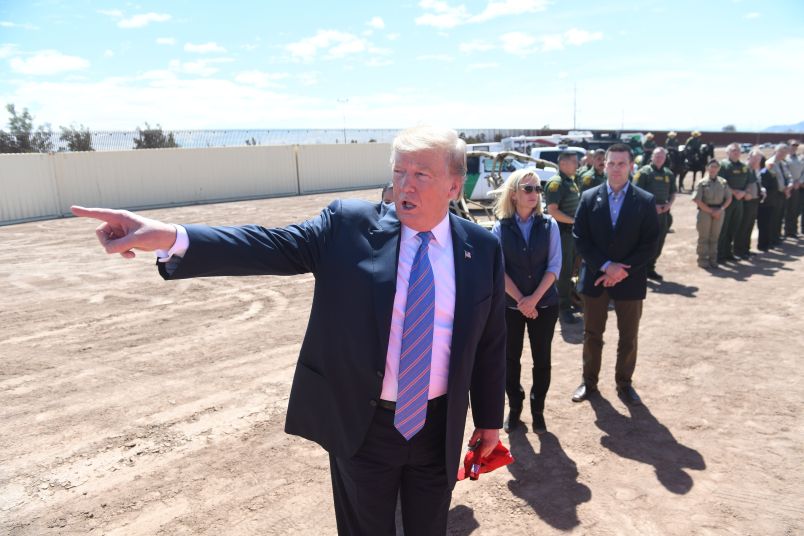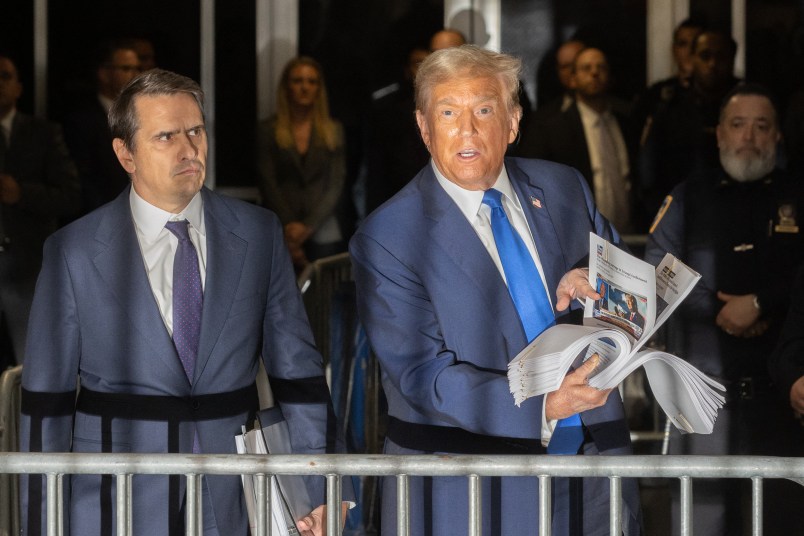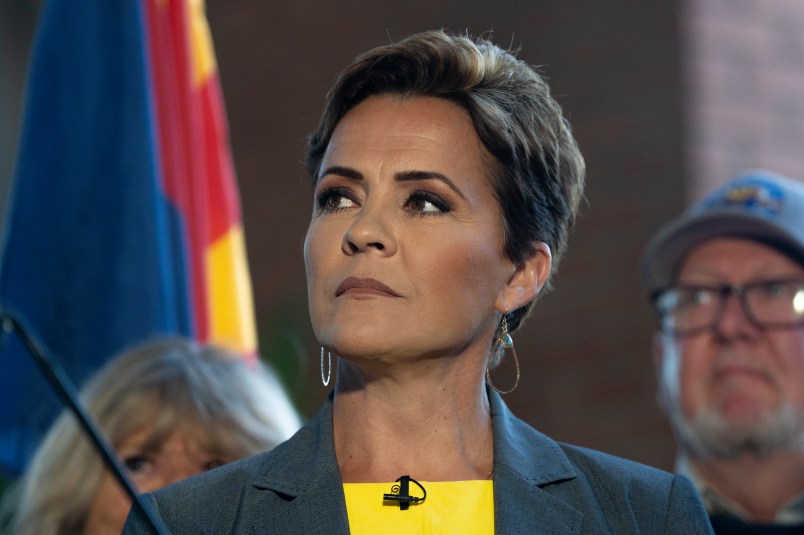President Donald Trump kicked off his campaign back in 2015 by attacking immigrants and Mexico. Now, as the 2020 campaign begins in earnest, Trump has ramped up his incendiary anti-immigrant rhetoric yet again.
“Secure the Border NOW” one subject line from Trump’s campaign blared on Monday, above an email that asserts the country is “too full, and the problem will only get worse until we secure the border.” “FINISH THE WALL” another recent email yelled, before telling its recipient that “Democrats have chosen illegal immigrants over the American people for too long.”
Trump himself has worked hard to keep the issue in headlines and cable news chyrons with a dizzying flurry of firings of senior officials, proclamations, threats, and reports of stunning behind-the-scenes orders to border officials and agents on the ground. As in 2018, it appears Trump wants to make immigration and asylum law central issues of the 2020 elections.
To make some sense of all this, we’ve put together a recent timeline of Trump’s obsession with the border and the asylum-seekers and migrants crossing it. It starts with a year: 2007, the last time peak monthly apprehensions were greater than they were this March. After the end of the month, DHS officials put March’s count of apprehensions and encounters at more than 103,000, including people seeking asylum. Of that number more than 56,000 were part of family units, up from 36,000 in February.
Thursday, March 28
Trump goes on the attack, blaming Mexico for doing “NOTHING” to stop the “flow” of migrants. He says the “Northern Triangle” countries — Honduras, Guatemala and El Salvador, where most border-crossers originate — “have taken our money for years, and do Nothing.” He warns: “May close the Southern Border!”
Later in the day, at a campaign rally in Michigan, Trump mocks the asylum process — required by U.S. law — as a “big fat con job.”
Friday, March 29
DHS Secretary Kirstjen Nielsen repeats what has by now become the administration’s standard request, urging Congress in a letter to make changes to the so-called Flores settlement and the Trafficking Victims Protection Reauthorization Act to allow for the indefinite detention of families as their asylum cases proceed, and to allow for the immediate deportation of children from Central America who don’t have asylum claims.
She also repeats the call for more bed space in ICE facilities and Health and Human Services-contracted facilities, so that the government has more space to hold families and children rather than releasing them into the country with a court date.
Trump threatens, more explicitly this time, that he’ll close the border “or large sections” of it, if Mexico doesn’t stop “ALL” illegal crossings on its side of the border. Trump says he will order the elimination of foreign aid to the Northern Triangle counties. “No money goes there anymore,” he says. “We’re giving them tremendous aid. We stopped payment.”
Saturday, March 30
The State Department confirms that the United States will cut off aid to the Northern Triangle countries.
Tuesday, April 2
Trump reiterates his vague border closure threat, demanding a congressional “deal” and telling Mexico to “do what it should be doing.”
In addition to proposed sweeping changes to the immigration system, Trump says, “you have to get rid of judges.” Two weeks later, counselor to the President Kellyanne Conway will say Trump was referring to federal judges.
In an appearance on Tucker Carlson’s Fox News show, Nielsen says radical proposals like ending birthright citizenship are “on the table.”
Thursday, April 4
Trump punts on his threat to close the border, giving Mexico “a one year warning, and if the drugs don’t stop, or largely stop, we’re going to put tariffs on Mexico and products, in particular, cars.”
Friday, April 5
Trump visits Calexico, California, and is pictured publicly with Nielsen for the last time before her resignation, which will come two days later. McAleenan is there also, as are border officials, local sheriffs and other law enforcement agents.
In a television broadcast of the meeting, Trump tells agents, “I was telling some of the people before: If it’s full, there’s nothing you can do about it. We have some horrible court decisions that have been made over the years. It’s very unfair and that’s the way it is. But the system is full. And when it’s full, there’s nothing you can do. You have to say, ‘I’m sorry, we can’t take you.’”
According to a later CNN report, Trump tells agents in Calexico not to let in asylum seekers, and to tell them that the country is full. The agents’ superiors reportedly tell them that Trump’s direction was not an order, and that they’d be legally liable for breaking the law if they followed it.
On the same trip, according to later reports from CNN and The New York Times, Trump reportedly dangles a pardon in front of McAleenan, telling him he would get a pardon if it was later determined that McAleenan broke the law by refusing entry to asylum seekers. Per both reports, sources said it was unclear whether Trump was joking.
The same day, Trump tells reporters he’s withdrawing the nomination of acting ICE Director Ronald Vitiello to lead the agency permanently, saying “Ron’s a good man but we’re going in a tougher direction.”
Saturday, April 6
Speaking to the Republican Jewish Coalition, Trump says “our country’s full” and accuses people seeking asylum of carrying out “a scam” and abusing U.S. law.
Sunday, April 7
Kirstjen Nielsen resigns. A person “close to” Nielsen tells Politico: “There’s definitely a larger shakeup abreast being led by Stephen Miller and the staunch right wing within the administration … They failed with the courts and with Congress and now they’re eating their own.”
Monday, April 8
Secret Service Director Randolph “Tex” Alles confirms he’s resigning as well. After the White House announces his ouster, Alles says he “was told weeks ago by the Administration that transitions in leadership should be expected across the Department of Homeland Security.”
A federal judge says he will block the Trump administration’s policy of forcing asylum seekers to wait in Mexico for their first screening interview. The order is scheduled to go into effect Friday, April 12. However, on that Friday, an appeals court overturns the stay just as it is about to go into effect, telling the Trump administration it can continue forcing asylum seekers to wait in Mexico as the case proceeds, for now.
Tuesday, April 9
Nielsen announces that acting DHS Deputy Secretary Claire Grady is resigning as well, clearing the way for CBP Commissioner Kevin McAleenan to become acting DHS secretary, leaving an acting CBP commissioner in his wake.
Following reports that he’d pressed for the reinstatement of the family separation policy — which would directly defy a judge’s order — Trump said he was not reinstating the policy. But, in the same breath, he asserted it was effective. “Once you don’t have it, that’s why you see many more people coming,” he said. “They’re coming like it’s a picnic, because ‘Let’s go to Disneyland.”
NBC News reports that White House adviser Stephen Miller has advocated internally for border agents, rather than Citizenship and Immigration Services officers, to perform initial asylum screening interviews, believing border agents will be tougher in vetting asylum seekers’ claims.
Wednesday, April 10
ICE confirms that acting ICE Director Ronald Vitiello’s last day will be Friday, April 12. Politico reports that the anti-immigration advocate and Trump administration staffer Julie Kirchner could eventually take the place of U.S. Citizenship and Immigration Services Director Francis Cissna, who various reports indicate could be the latest to lose his job.
Thursday, April 11
The Washington Post first reports that Trump has considered busing undocumented migrants released by ICE to sanctuary cities as retaliation for their elected representatives’ opposition to greater amounts of bed space in detention centers.
The White House says the idea was simply “floated and rejected,” but following the report, Trump will float the idea several more times on Friday and Saturday, on Twitter. On Sunday, the New York Times reports that Trump revived the idea “in part, people close to him said, to distract from the [Mueller] report.”
Per BuzzFeed, Vitiello tells ICE employees Acing Deputy ICE Director Matt Albence will take over agency leadership by Friday, April 12.
Saturday, April 13
Responding to reports from The New York Times and CNN the previous day, that he offered CBP Commissioner McAleenan a pardon on April 5 if McAleenan was ever found to have broken the law by closing the border at Trump’s request, Trump denies he ever dangled a pardon.
Sunday, April 14
Trump officials say they’re considering putting countries whose nationals most frequently overstay their visas “on notice”: Per WSJ, “future visas could be shorter or harder to get” as a result.
In addition, per the report, the administration is seeking a rule “preventing immigrants from coming or becoming citizens if they are likely to use publicly funded benefits.” Or, in White House spokesman Hogan Gidley’s words,” working to … ensure faithful implementation of immigration welfare rules to protect American taxpayers.”










